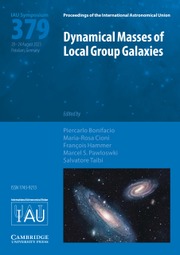No CrossRef data available.
Article contents
Chandra and XMM Observations of Galaxy Groups: The Influence of Central AGN at the Low End of the Cluster Mass Scale
Published online by Cambridge University Press: 01 August 2006
Abstract
Chandra and XMM, offering between them high angular resolution, substantial collecting area, and spatially-resolved spectroscopy at good spectral resolution, have given us the means to discover hitherto unanticipated phenomena, in groups as in clusters, and to explore a new set of issues that bring us closer to understanding the formation and evolution of groups and their constituent galaxies: the distribution of heavy elements, the presence of X-ray cavities and their relation to radio observations, the nature of cooling cores, and X-ray signatures of recent galaxy interactions. We here show Chandra and XMM data selected to illustrate recent results regarding some of these themes.
Information
- Type
- Contributed Papers
- Information
- Proceedings of the International Astronomical Union , Volume 2 , Symposium S235: Galaxy Evolution Across the Hubble Time , August 2006 , pp. 255
- Copyright
- Copyright © International Astronomical Union 2007

